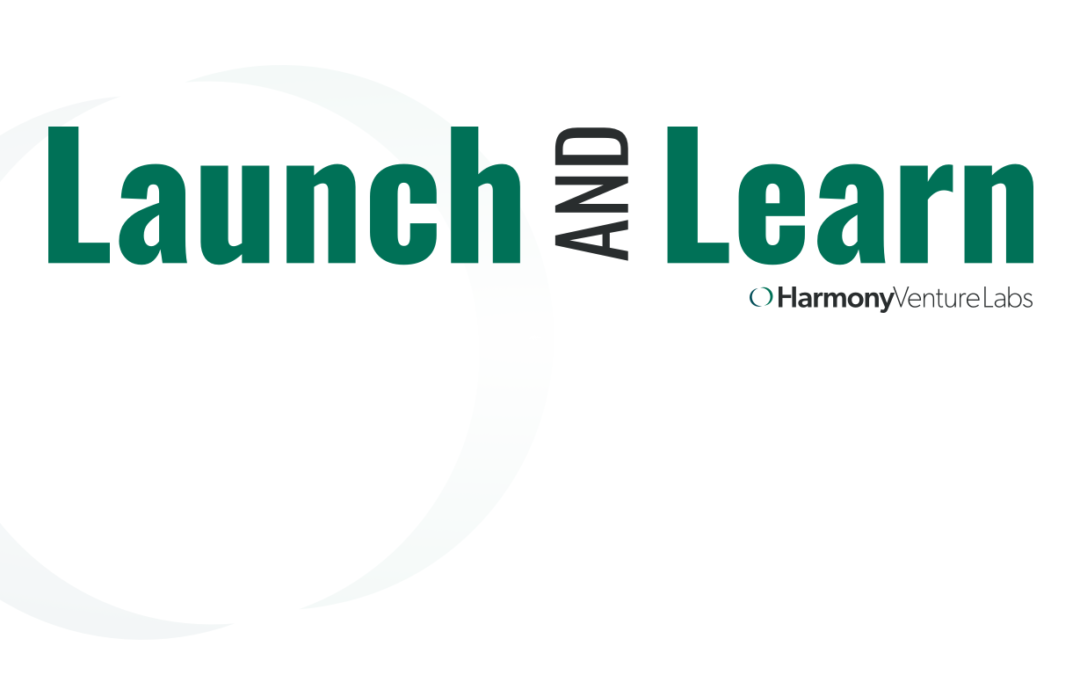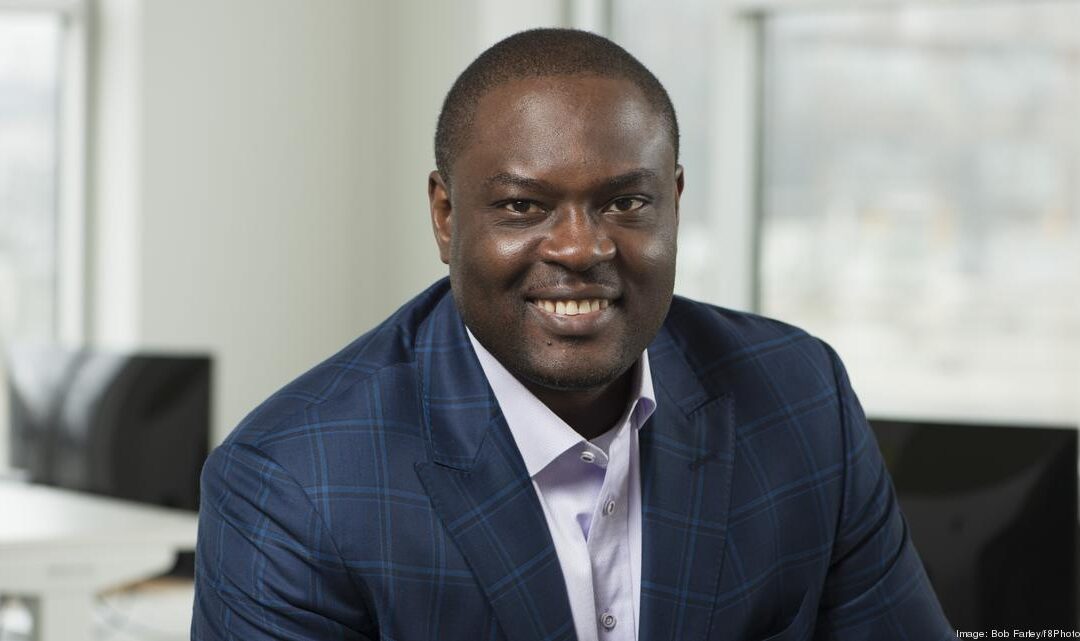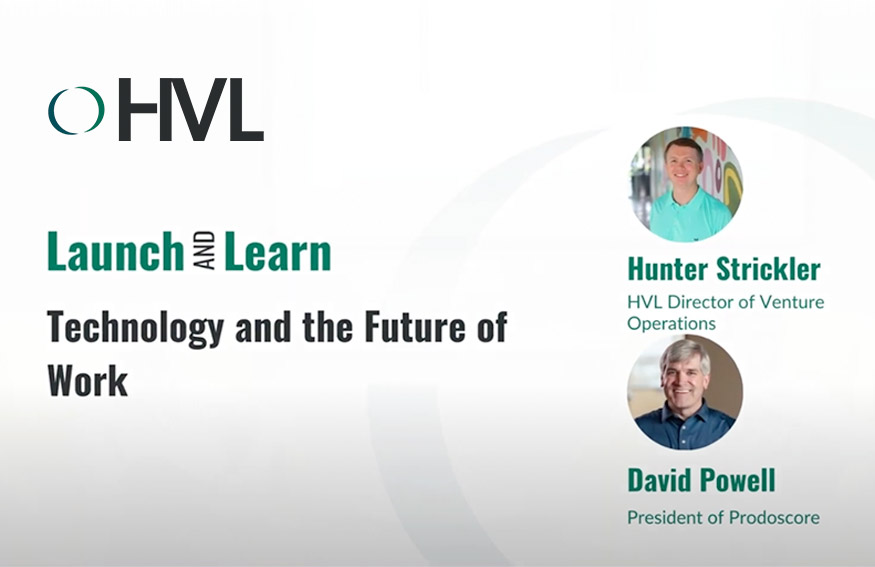Sara Beth: I want to welcome everyone to our fourth Launch & Learn! Our last Launch & Learn on product design went well—if you did not catch it, it’s located on our YouTube channel.
Today we’re going to be talking about Entrepreneur-in-Residence programs. We’ll cover what they are and what our vision for them is here at HVL. I know we’re all excited to hear from Shegun and Trevor. But first off my name is Sara Beth, the talent acquisition specialist at HVL and for our portfolio companies.
Today, we have both Shegun and Trevor as panelists. Trevor Newberry is the Director of Product Delivery at Harmony Venture Labs, where he oversees the validation and development of new ideas and concepts. Prior to HVL, Trevor owned and operated Newberry Consulting Service and worked with first-time and non-technical founders to help them turn their ideas into software products.
Next up is Shegun Otulana. Shegun is the founder and CEO of Harmony Venture Labs, an idea and growth studio that owns and operates a family of technology companies. He also serves as the CEO of Copysmith AI, a startup that uses artificial intelligence for content generation. In 2013, Shegun started Theranest and its parent company, Therapy Brands, the leading provider of software technology solutions for mental, behavioral, substance use disorder, and physical rehab providers. Prior to that, he founded Zertis Technologies, a computer software consultancy company. Shegun resides in Birmingham with his wife, Mary, and their four children.
Again, welcome everyone. Before we start, I want to remind everyone that there’s a chat feature at the bottom of the screen. So feel free to drop in any questions you may have throughout the session—we really want this to be a conversation. We’ll address those after the discussion. Now let’s start at a high level, either Shegun or Trevor—can you start off by telling us just what an EIR is and what our vision at HVL is for what that program is going to look like?
Trevor: There are a lot of different flavors of EIR programs, but the overarching idea for us at HVL is to be taking concepts, validating them, turning them into products, and launching companies around these products. And if you think a little bit deeper into that, the logical conclusion is that we need people to help us run those products, to help manage the development and delivery process. Hopefully, we’ll be launching up to four, maybe five or six new products and companies a year.
An EIR program helps companies, venture studios, and venture capital firms identify talented people who can come in with the requisite experience. Even though they don’t always line up like this, the intent behind the program here at HVL is for the EIRs to participate in the process of developing these concepts into products and then launching them. Ideally, they would then go out and help lead that company after we take it to market.
Shegun: Yeah. We believe that we have the opportunity to create great products, bring those products to market, and build great teams around those products. Which can then turn into great companies and create a lot of value.
We see this program as a way for us to get fellow founders and cofounders to come and join us on that journey. Whether it’s companies we acquire or companies that we build from scratch—we believe that there’s enough talent to step into leadership roles in those companies and help us carry the journey on.
This is our way of introducing that to the world and to our community here in Birmingham. We’re hoping that we can educate you all and get everybody excited about what we’re trying to do here at HVL.
Sara Beth: That’s awesome. And for those of us who are somewhat new to EIR programs, Shegun and/or Trevor, how do we see this playing out in Birmingham? What are other companies that have already done this? Who would we say has other successful EIR programs?
Shegun: They don’t always get called EIRs. Some people call them different things, but you’ll see this in a lot of VC firms or sometimes internally in the corporate environment.
Some companies you guys may know that had EIRs ended up stepping into leadership roles. It would be things like Snowflake, or Hims and Hers. There are several other companies like that, a lot of venture studios, and EIR/co-founder-type programs that then come in and turn those companies around.
Another example can even be Biso, which is a locally owned company here in Birmingham. I know they acquired a company that probably didn’t have somebody to step into a leadership role where—they may not formally call it an EIR program, but it’s functioning in a similar way.
Sara Beth: And so as far as “what’s in it for the candidate?” What would the EIR gain by participating in our particular program?
Trevor: Honestly, I think that this is a really neat opportunity and you’re going to have access to all HVL resources. This isn’t asking you to come in and build the thing yourself, it’s being a part of what we do. We resource our new concepts as we’re building them. So you’ll have access to a team of experts with a lot of good experience working with B2B SaaS products.
I also think it’s a really good transition for a former founder or department lead. Someone who has experienced leading software teams. Whether it’s a department or at the head of the company, it’s a great opportunity to get exposure to a lot of different concepts.
Now, we will be developing more than a single concept each quarter. You might be working to build one single concept, but you’ll also be exposed to a lot of different ideas coming in through our funnel. Think about it as a crash course on creativity and ideation validation.
Finally, it’s an opportunity to go on and lead a company as well. Like Shegun mentioned, the intent here is to find the talent that these companies and these products need, to lead them successfully—not just to get them up and out.
Shegun: Yeah. We’re looking for what we can call, “find a company fit”. So you get the chance to work with the team here at HVL and learn first-hand how to accelerate growth in a company. And if it happens that there is no founder-product-fit, you have gained a lot of experience, which can be leveraged in another opportunity down the road.
It is a compensated role, so we don’t expect people to just come and do it for free. But hopefully, we can find great partners who can be part of that journey. And I don’t know if we want to talk about the ideal candidate or not Sara Beth?
Sara Beth: That was actually gonna be my next question. It’s kind of hard to talk about what they’ll gain without talking about who they are. So if you want to launch into our ideal candidate for the program that’d be great.
Shegun: Trevor you work a lot with the product delivery process. So you can dive into that and I’ll add color as needed.
Trevor: Yeah. t’s not a terribly complicated set of qualities that we’re looking for. Specifically, we want experience in B2B SaaS since that’s our particular focus here at HVL—building B2B SaaS products. We’re very intentional about that. So experience with those kinds of products and companies is really important.
Also, leadership. These folks will be responsible for participating in the development and delivery of these products, but they’ll also be responsible for a team. As these products are launched, the ability to lead and to coach the respective team becomes really important as well. And I don’t necessarily mean at the CEO or founder level, it could be at a director level leading a functional area. I think anyone that works in the product field would be a great fit as well.
Shegun: I think for the leadership, CEO, founder, and co-founder role—we will be looking for experience in a B2B SaaS environment. So, have you led a product team? Have you been a founder and maybe your product didn’t succeed but you’re still eager to kind of go out there and do it again? Have you been the head of design and a successful product—maybe not very successful—but you did a really great job? These are really the kind of people we’re looking for. Obviously, we’re going to provide the environment, coaching, resources, and a launch team around you.
That would be the ideal profile for the person we’re looking for. You don’t have to have expertise in the industry that you may end up leading. Depending on the situation, there are some situations where expertise is pretty critical—but you do have to have experience in technology companies, SaaS companies, startups, leading teams—whether that’s a small group or a large group, you definitely have to have resourcefulness, grit, the ability to follow through, the ability to learn quickly and assimilate what you learn. And obviously, fit with the kind of people that we would want to do this with. Someone with integrity who can put the team ahead of their own ego. Those would all be characteristics of ideal candidates.
And for those of you on the call, who knows, you may know those people or it may be you—we’re here getting the word out!
Sara Beth: How long do we envision this program lasting? What if someone is currently employed by another company currently, how does that mix into what our vision is for this program?
Trevor: Currently, we are talking about a three-month engagement with an option to extend potentially being offered as well. That’s the thing about the startup process. It’s a little bit of controlled chaos which I’m sure there’s a lot of people on the call that probably understand. And so it’s entirely possible that the product may not actually be as successful as we hope for it to be.
We want to have an opportunity, especially if it’s a really good fit with this person, to actually extend that engagement for another quarter to see if there’s another idea that we can get up and out the door. Obviously, we all want to be able to stay on track with our launches but just being realistic about the way that startups go, that may not always be feasible.
Shegun: Yeah, we’re a marching band wrapped around a jazz band. So, sometimes the jazz band can’t make good music and in that case, we may try to see if we can produce even better music next time. But yes, that’s the timeline.
Sara Beth: And branching out further, kind of going back to EIRs in general. Can you guys talk about how the traditional model of an EIR program is and how it has changed over time specifically in this industry?
Trevor: In terms of how it’s changed over time, I’m probably not the right person to speak to that. But what I can say is that there are as many different flavors of EIR programs and what is expected of the participants in those programs as there are companies that offer those programs. It’s hard to find a “one size fits all” definition.
The expectations are obviously different. We’ve mentioned a couple of companies already, but there are also things like an executive-in-residence with a program like Reforge. And in that particular model, they’re not just standing up products and getting them out the door, they’re actually participating in content creation.
So, depending on the company and what it is that they’re producing or what their business model is—you’ll find a very different flavor to this type of program. Ours is very specific to creating and launching B2B SaaS products.
Shegun: Yeah. You have to be bringing something to the table.
Based on your experience, can you drive engineering output? Can you really drive product output? Are you a go-to-market specialist? So, what exactly is the value add that we can build around to accelerate is a big part of what we’re looking for.
Trevor: Our process is very momentum-driven. So, a big focus is on being able to move things forward and actually producing on a regular basis. Someone who’s worked with non-technical and first-time founders—there’s a bad tendency to get caught in the spiral of decision-making after the product has begun developing and not having hands on a lot of those processes. There are a lot of moving parts, so we are definitely going to be moving anybody in this EIR program towards momentum, towards making sure that the deliverables are on time, that they’re at quality, etc.
Sara Beth: When you think about corporate companies that are coming out and innovation teams that have incorporated corporate EIR programs. How does that relate to the program we’re talking about here? And /or is it just completely different from our EIR?
Shegun: There is some difference. Corporate EIR programs are looking at building products within a company and then maybe taking leadership of that and driving it forward. And that skill set moves a lot. But we are looking for founders. We’re looking for people who have a strong opinion about a particular future and they want to build that future. They have a strong opinion about building companies, building teams, and winning in the market. And those are the kind of people who we’re really looking for. Now, even though those people also exist in corporate EIRs, the latter also have room for people who can be high-level managers.
At HVL, we’re looking for full ownership. We will help you along the way, but we’re looking for somebody who will take the reins as a fellow founder, alongside HVL and build great things.
Trevor: Yeah, I think the context is what’s different more than anything.
Sara Beth: But could someone with the profile of being in a corporate EIR and let’s say that they want to branch into the startup space, could that potentially be a fit for our candidate profile?
Shegun: If they have led teams who have actually successfully built a product and taken the product to market. And they had a functional leadership role or they had an overall leadership role. And that product profile is not an internal corporate product, it was actually served externally and they had to go to market and deliver and find distribution—definitely.
Sara Beth: And obviously talent in the workplace and the way we think about careers have just changed so much over time. So when we think about this, I think about it being sort of different from a lot of what we’re currently seeing in the market. Like—hey, I have a full-time open position, this is what I need to fill. This is not necessarily traditional in that sense. So how would you guys describe the career path for someone in this program? It sounds like this is almost like a pipeline of talent for us and that there’s a lot of different ways that we could potentially plug them into kind of the HVL family.
Shegun: This is a career path for somebody who wants to be an entrepreneur. In the sense of whatever career path entrepreneurship is, that’s really what this person is signing up for. I don’t know if there’s really a career path in this case but you take on the risk of an entrepreneur for the time that you do this.
It’s different from a typical traditional career path where you work within an organization and you move up the ranks as you build your career over time. This is really entrepreneurship with a downside risk limit and significant upside potential.
Sara Beth: Anything to add to that Trevor?
Trevor: No, I agree entirely. This is for folks who are interested in entrepreneurship, in being founders and leading. Because of what we do here at HVL, we all love the startup life. But it is, like I said, a little bit of controlled chaos. So, this person needs to be comfortable with that ambiguity that lives in this kind of environment. The career path of an EIR naturally translates from that. It could be leading a successful new company. Or it could not.
There’s a lot of unanswered questions there. But I think partnering with HVL does, like Shegun said, help mitigate some of those downright side risks. And it certainly provides a tremendous possible upside. I think that’s one of several reasons that it would be an attractive option.
Shegun: Yeah, and if you’re great at what you do but you’re not really the co-founder type, you can still reach out to Sara Beth, and we would love to form a relationship with you. And who knows where that could lead. We’re looking for talent across the board, not just at the EIR level. We may not have that position open today. But we would still love to build a relationship with you over the long term.
Sara Beth: Yeah. It looks like we’ve got one question, possibly two. This person says, “Great insight. What would someone study in college or what work experience would be ideal for someone wanting to be an EIR?
Shegun: I would totally discount college. Whatever you study, it doesn’t matter. Colleges have no relevance here. Like we’ve touched on already, experience is what we’re looking for.
Sara Beth: And then the second question we got is, “What market verticals and types of companies or products are HVL looking to make? Are you looking for entrepreneurs or founders, or looking for specific expertise, for example, SaaS, e-commerce, etc.?”
Shegun: Primarily SaaS and B2B specifically. From a market vertical standpoint, we don’t really have a particular market vertical but we do have certain things we’re betting on. For example, we believe AI is going to significantly change the future so we would make bets on those. We also believe that the ability to connect online and engage online will continue to be a big part of the future, so systems that are on e-commerce would be something that we’ll continue to look at as well.
Sales, automation, marketing, all that stuff. We believe that at some point COVID will end and human beings will come back together and do things together, and those will be areas where we will be monitoring. Health and wellness is another area that we’re very interested in. Also, we are under the belief that people will take more of their health into their own hands, general wellness will be something that we’ll continue to invest in as a society and as individuals.
But I’m not ruling out any other particular areas. Another thing I would add is that if you’re someone who has your own ideas, EIRs can take internally generated ideas and take them through the studio process. So, if you have ideas that you feel strongly about, and you truly believe that you can go through what it takes to prove them, HVL is interested in putting ourselves there in front of them.
Sara Beth: For those who are on the call who might be considering other potential competitors, what makes HVL different? Why would someone want to come to build and grow with us specifically?
Shegun: I don’t see other opportunities in the true sense of competitors. I think the people you work with is a really personal decision. And so people have to figure that out for themselves. The thing that is special about what we’re doing is the larger impact of what we’re trying to do here. I am really committed to the Birmingham community because it’s been a big part of my life. And I believe there’s a ton of potential here that we can unlock. We have the ability to do great things. We may not be able to do it all by ourselves and we may get people from external to our community to join us, but that’s life in this space, the whole world is one large community.
So, that’s part of what makes what we’re doing unique. We’re trying to build our own community and raise leaders from our community to the extent that our capabilities allow us. And I think that as you’re deciding–those are things to really consider. But if your vision aligns with other entities that do what we do and you find fit with them, I think creating the future is important and you should do very well.
Sara Beth: Well said. Anything to add Trevor?
Trevor: I mean as someone who is an employee at HVL, I can truthfully say that this team is one of the favorites I’ve ever worked with. I love that we are a founder-friendly team and that we care so much about the Birmingham community. That’s a mission and an element of our vision statement that Shegun has cast for everybody from the very beginning. And I think he’s done a great job sticking with that.
And I would echo that there’s not a lot of people who are competitors in the truest sense of the word. I think even the statement that Shegun just made about finding someone who is a better fit for building the future—is really important work to be doing. And I think that it speaks volumes about the way we approach the work we do and how we care about the entrepreneurial technology, community, and community at large here in Birmingham.
Sara Beth: That’s awesome. Well, thank you both. I think this was a really great discussion. I don’t think we have any more questions at this point so thank you everybody for joining.
If you are interested, definitely go to www.harmonyventurelabs.com and check us out on LinkedIn and Twitter. You can also reach out to me on LinkedIn as well with any specific questions you may have about the EIR program or any of our other open positions that we have. And again, we’re posting new positions every day so even if it’s not posted, we’d love to hear from you and connect.



